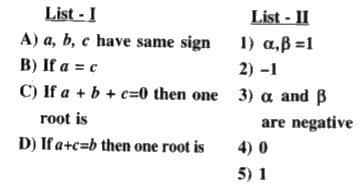One of the roots of ax2+bx+c=0 is greater than 2 and the other is less than -1. If the roots of cx2+bx+a=0 are αandβ, then
0<α<12and−1<β<0
α<12andβ<−1
α>12andβ>−1
α<2andβ>−1
The correct Answer is:1
To solve the problem step by step, we will analyze the given quadratic equations and the relationships between their roots.
Step 1: Understand the given equations
We have two quadratic equations:
1. ax2+bx+c=0 with roots γ and δ.
2. cx2+bx+a=0 with roots α and β.
We know from the problem that one root of the first equation is greater than 2 and the other is less than -1.
Step 2: Set up the inequalities for the roots
Let’s denote the roots of the first equation as:
- γ>2
- δ<−1
Step 3: Use the relationship between the roots
The roots of the second equation cx2+bx+a=0 are the reciprocals of the roots of the first equation. Thus:
- α=1γ
- β=1δ
Step 4: Analyze the implications of the inequalities
Since γ>2:
- α=1γ<12
Since δ<−1:
- β=1δ>−1
Step 5: Combine the results
From the analysis, we have:
- α<12
- β>−1
Step 6: Determine the ranges for α and β
Since α must be positive (as γ>2 implies α<12 and cannot be negative), we conclude:
- 0<α<12
- β>−1
Final Result
Thus, the ranges for the roots α and β are:
- 0<α<12
- β>−1
We have two quadratic equations:
1. ax2+bx+c=0 with roots γ and δ.
2. cx2+bx+a=0 with roots α and β.
Let’s denote the roots of the first equation as:
- γ>2
- δ<−1
The roots of the second equation cx2+bx+a=0 are the reciprocals of the roots of the first equation. Thus:
- α=1γ
- β=1δ
Since γ>2:
- α=1γ<12
- β=1δ>−1
From the analysis, we have:
- α<12
- β>−1
Since α must be positive (as γ>2 implies α<12 and cannot be negative), we conclude:
- 0<α<12
- β>−1
Thus, the ranges for the roots α and β are:
- 0<α<12
- β>−1
Topper's Solved these Questions
- BOOK - CENGAGE ENGLISHCHAPTER - THEORY OF EQUATIONSEXERCISE - Multiple Correct Answer Type38videos
THEORY OF EQUATIONS
- BOOK - CENGAGE ENGLISHCHAPTER - THEORY OF EQUATIONSEXERCISE - Linked Comprechension Type37videos
THEORY OF EQUATIONS
- BOOK - CENGAGE ENGLISHCHAPTER - THEORY OF EQUATIONSEXERCISE - CONCEPT APPLICATION EXERCISE 2.139videos
THEORY OF EQUATIONS
- BOOK - CENGAGE ENGLISHCHAPTER - STRAIGHT LINESEXERCISE - ARCHIVES (NUMERICAL VALUE TYPE)1videos
STRAIGHT LINES
- BOOK - CENGAGE ENGLISHCHAPTER - THREE DIMENSIONAL GEOMETRYEXERCISE - All Questions294videos
THREE DIMENSIONAL GEOMETRY
Similar Questions
Knowledge Check
- Question 1 - Select One
If one root of the equation ax2+bx+c=0 is the reciprocal of the other root, then
Aa + b = 0Ba - b = 0Ca - c = 0Db - c = 0
If α,β are the roots of x2+bx+c=0 and, α+h,β+h are the roots of x2+qx+r=0 then h =
View SolutionIf 0>a>b>c and the roots α,β are imaginary roots of ax2+bx+c=0 then
View SolutionIf α,β are the roots of x2+bx−c=0, then the equation whose roots are b and c is
View SolutionIf a, b, c are in geometric progresion and the roots of the equations ax2+2bx+c=0 are α and β and those of cx2+2bx+a=0 are γ and δ then
View Solutionα,β are the real roots of ax2+bx+c=0 observe the following lists

then the correct matching isView SolutionIf α,β are the roots of ax2+bx+c=0 then α5β8+α8β5=
View SolutionLet both root of equation ax2−2bx+5=0 are α and root of equation x2−2bx−10=0 are α and β . Find the value of α2+β2
View Solution

